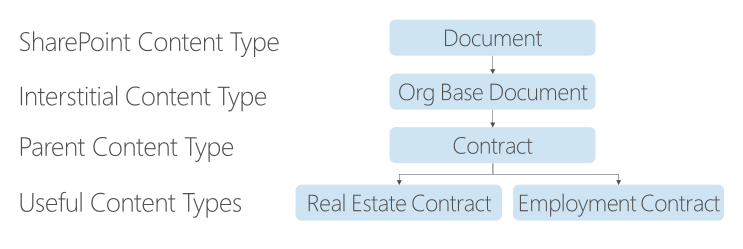Taking Advantage of the Content Type Inheritance Model in SharePoint
Note
This is an open-source article with the community providing support for it. For official Microsoft content, see Microsoft 365 documentation.
Taking advantage of the Content Type hierarchy is an important part of a powerful information architecture, regardless whether you're working with documents, list items, pages, etc.
Let's use this example to illustrate the points:

SharePoint gives us the _Document Content Type "out of the box". Every Document Library you create in SharePoint (assuming you don't use some fancy template) has the Document Content Type enabled for it. So many people just start dumping their files into the Documents (aka Shared Documents) library with every file becoming a Document and then wonder why no magic is happening.
In the example above, we have two interstitial Content Types. (Interstitial - or interstices - means spaces between things.) We can create these interstitial Content Types, but never enable them in a Document Library; they generally only exist to create a strong content hierarchy.
- Org Base Document - When you start setting up the information architecture in a tenant, it makes sense to create a Content Type like this, usually putting the name of the organization in place of "Org". You may never touch this Content Type again after you create it, but it really comes in handy when someone says something like, "let's add X to ALL our custom Content Types".
- Contract - This is also a Content Type which we may not ever enable in a Document Library, but it allows us to search for Content Types which inherit from it.
Most of the time, you'll want to create Org Base Document and Contract at the tenant level (in the Content Type Hub, via the Content Type Gallery in the SharePoint Admin Center). We use that enterprise level capability for Content Types which may be used in one or more sites. It gives us a central place to manage our information architecture - where it makes sense to do so. Since we're going to inherit from Org Base Document for all the custom Document-derived Content Types, we create it at the tenant level.
When we set up a custom Content Type and inherit from an existing Content Type, there's a brilliant logic under the covers. The out of the box Document Content Type at the tenant level has its ContentTypeId=0x0101. 0x0101 represents a Document in every tenant. (See: Base Content Type Hierarchy for the full list of base Content Types in SharePoint.)
When we create the Org Base Document Content Type in the Content Type Gallery, it gets a ContentTypeId which starts with 0x0101 and then has a unique GUID-like part. Here is an example full hierarchy tree for the Content Types with their ContentTypeIds in a tenant. (Your actual ContentTypeIds will vary.)
| Content Type | Inherits from | ContentTypeId |
|---|---|---|
| Item | [System] | 0x01 |
| Document | Item | 0x0101 |
| Org Base Document | Document | 0x0101002FBDBE6A1A315F438E41F10681463A61 |
| Contract | Org Base Document | 0x0101002FBDBE6A1A315F438E41F10681463A6101 |
| Employment Contract | Contract | 0x0101002FBDBE6A1A315F438E41F10681463A610101 |
| Real Estate Contract | Contract | 0x0101002FBDBE6A1A315F438E41F10681463A610102 |
As you can see, the inheritance model makes a lot of sense. Each inheritance appends something unique to the ContentTypeId. Once we've enabled the appropriate Content Types in Document Libraries (in this case), we can take advantage of the hierarchy using queries like:
| Intent | Query |
|---|---|
| Show me all my custom Content Type -based documents | ContentTypeId:0x0101002FBDBE6A1A315F438E41F10681463A61* |
| Show me all the Contracts | ContentTypeId:0x0101002FBDBE6A1A315F438E41F10681463A6101* |
| Show me all the Employment Contracts | ContentTypeId:0x0101002FBDBE6A1A315F438E41F10681463A610101* |
Show me all the Contracts is the really powerful query here. By requesting all content with a ContentTypeId which starts with the Contract Content Type's ContentTypeId (That's what the asterisk does for us.), it doesn't matter if we create a new Content Type inheriting from Contract. The query will automagically continue to do what we want because the next Content Type inheriting from Contract will have a ContentTypeId of 0x0101002FBDBE6A1A315F438E41F10681463A610103. In other words, the ContentTypeId:0x0101002FBDBE6A1A315F438E41F10681463A6101* query will just pick that new content up for us without any adjustment.
Pair this good information architecture with the PnP Modern Search Web Parts, and you can build search-driven experiences which are highly specific, easily maintained, and extremely reliable. This is NOT "just Google". It's you building solutions to match the user stories and content needs in YOUR organization. If you extrapolate from these examples, you probably can imagine some potential hierarchies in your information architecture which may help you create more powerful solutions for your end users.
Principal author: Marc D Anderson, MVP
Microsoft 365 community content
Feedback
Coming soon: Throughout 2024 we will be phasing out GitHub Issues as the feedback mechanism for content and replacing it with a new feedback system. For more information see: https://aka.ms/ContentUserFeedback.
Submit and view feedback for